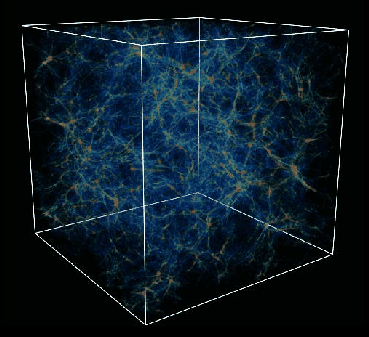Simulating the Universe

Credit & Copyright: G. L. Bryan, M. L. Norman,
UIUC,
NCSA,
GC3
Explanation:
The
above cube
represents a chunk of our universe as simulated by the Grand Challenge
Cosmology Consortium (GC3). The cube is huge - it would take light 500
million years to cross it. Low density gas is shown as blue, and high
density gas as red. In the beginning of the
universe, matter and gas were
spread quite
uniformly. As this computer universe
evolved, gravity caused high density areas to be created. This simulation
hypothesized that 1/3 of the universe is composed of slow moving "cold dark
matter", and 2/3 composed of fast moving "hot dark matter." The areas of
high and low density resulting from this computer simulation are similar to
those observed by astronomers in the
real universe.
Authors & editors:
Robert Nemiroff
(MTU) &
Jerry Bonnell
(USRA)
NASA Web Site Statements, Warnings,
and Disclaimers
NASA Official: Jay Norris.
Specific
rights apply.
A service of:
LHEA at
NASA /
GSFC
& Michigan Tech. U.

